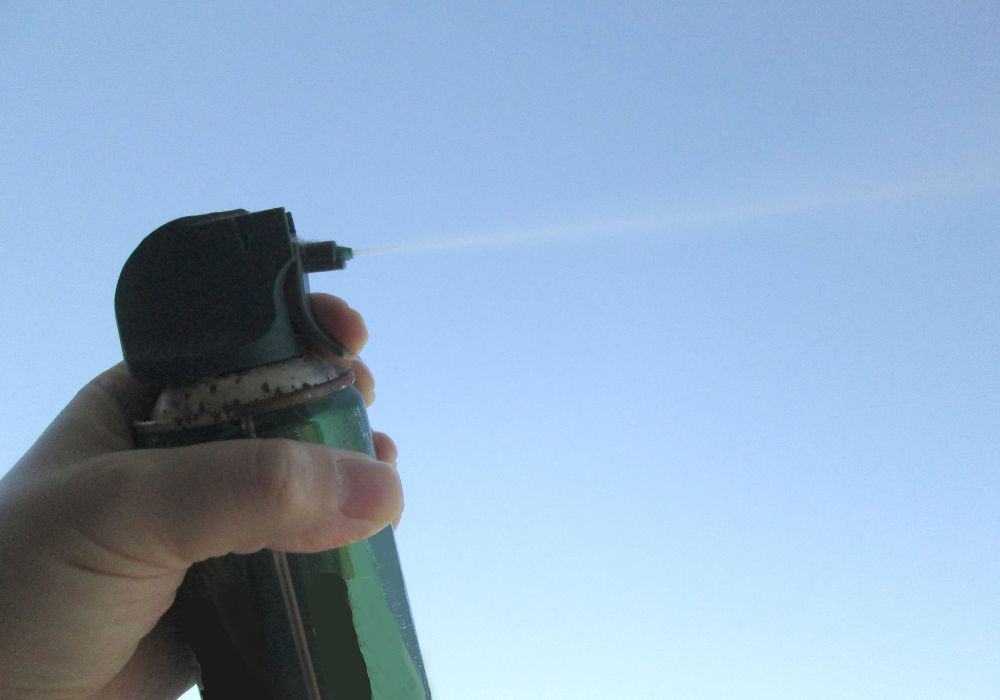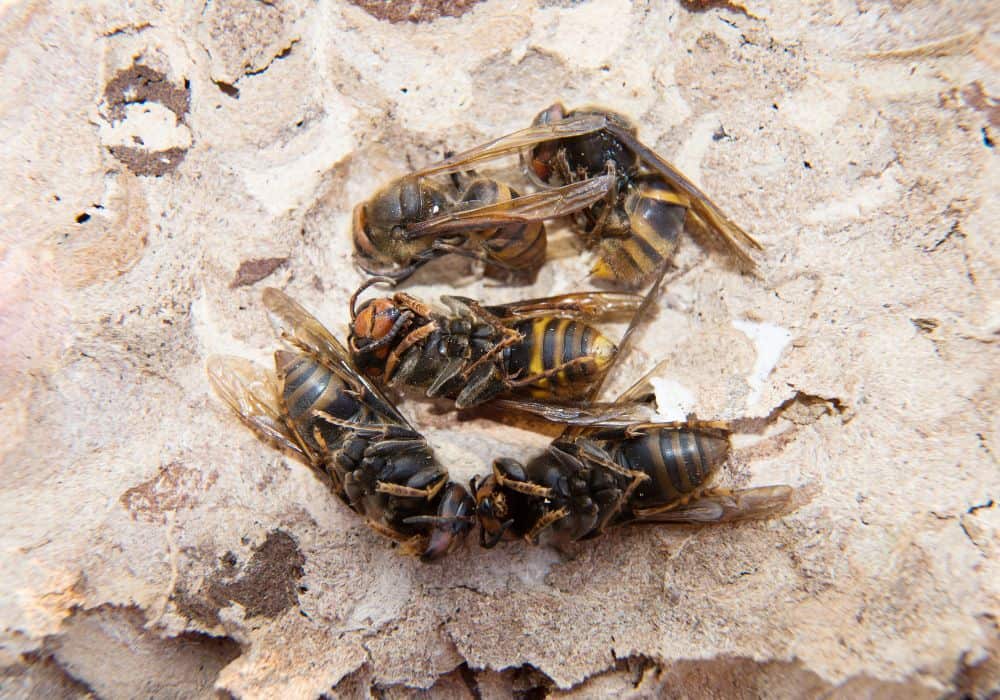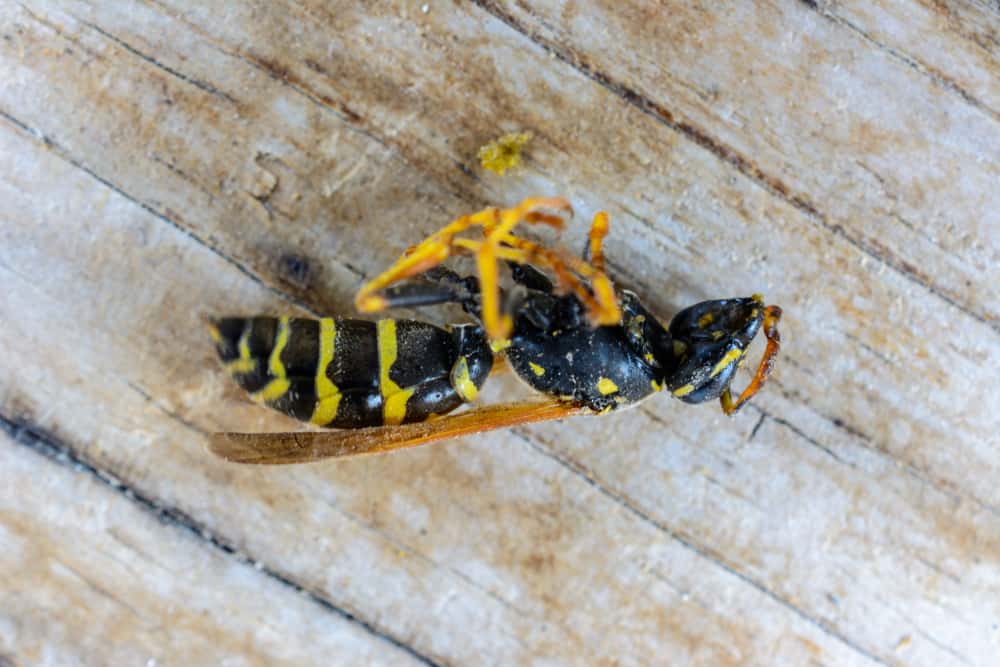Seeing wasps and hornets menacingly flying around your home regularly is a tell-tale sign that it’s time to call the exterminator. But while pest control professionals are the best way to get rid of pest infestations, they don’t exactly come the minute you call.
For many of us, the kneejerk reaction to seeing creepy wasps flying around is to grab some wasp and hornet insecticide and spray at it at the flying insects point-blank. Within seconds, the wasps fall to the ground, writhing until they’re killed.
Wasp insecticide is a panic button we rely on as soon as we see wasps. They’re incredibly effective in the short term, so they’re an excellent instantaneous solution. But have you ever stopped and asked yourself—why does wasp insecticide instantly kill wasps?
Today, we’ll give you the lowdown on what makes wasp insecticide so powerful, whether it’s toxic to people, and how to properly use it on wasps. Keep reading to see all this information and more!
What Chemicals in These Insecticides Kill Wasps and Hornets?

The reason why wasp insecticides kill wasps and hornets (as well as other insects and pests around them) is because of active ingredients called pyrethroids and pyrethrins. Concentrations of these chemicals are packed in the little aerosol cans that you know as insecticides.
It all starts with pyrethrum—a chemical compound found in chrysanthemum flowers. This natural substance was first used to kill insects like flies and mosquitos back in 19th-century Asia.
There are six known molecules in pyrethrum responsible for killing insects so effectively. These molecules are known as pyrethrins. Pyrethrins aren’t just excellent at killing insects. They also break down quickly in the environment, making them quite eco-friendly.
Over the centuries, scientists worked hard to recreate insect-killing pyrethrins in labs. Eventually, they were able to create pyrethroids—the synthetic, man-made version of a pyrethrin that is very similar in chemical makeup.
When you look at your water-based wasp spray bottle, you might not see pyrethroids or pyrethrins on the ingredient list. That’s because these chemicals are a huge group of substances. The active ingredients on your spray will be chemicals under these classes.
Here are some names of pyrethroid and pyrethrin compounds you might see on your bottle instead:
- Tetramethrin
- Sumithrin
- Resmethrin
- Phenothrin
- Bioallethrin
- Cypermethrin
- Deltamethrin
- Permethrin
- Prallethrin
These pyrethroids are present in over 2,000 pesticides today. While these chemicals all have different names, they work pretty much the same way. Once a wasp ingests one of these, it slowly breaks down its nervous system. This quickly leads to paralysis. In just a few moments, they die.
All the chemicals listed above are effective for all kinds of wasps and hornets, from paper wasps to yellow jackets. They’re so effective that they might feel the debilitating effects even just walking over a surface where pesticide has dried up. They can also be toxic to fish.
Are Pyrethroids Toxic to Human Beings?

Worried about harming your own body if you ingest pyrethroids in your pesticides? Don’t worry. Fortunately, pyrethrins and pyrethroids have low toxicity for humans and most mammals.
Experts say they’re over 2,000 times more toxic to bugs and insects because of their small size and naturally low body temperature.
That said, there are still a few ways pyrethroids can harm the human body. A study on male rats showed that permethrin, a type of pyrethroid, can negatively affect fertility. Although there’s no evidence that it happens to humans too, it’s still best to be careful.
Pyrethroids in pesticides can also be irritating if they get on your skin. Your skin can get itchy, sensitive, and tingly, sometimes even causing numbness. Getting it into your eyes can also lead to a painful, burning sensation as well as blurred vision.
And just like any foreign substance, inhaling too much insecticide can irritate your nose and throat. This can lead to some mild, acute coughing, sneezing, and a runny nose.
But don’t worry, these symptoms don’t last forever. When pyrethroids and pyrethrins are ingested by mammals, they’re simply absorbed by the body and ejected in urine or poop in the next day or two.
How Long Do You Have to Wait Until Insecticide Kills Wasps?
It doesn’t take long for wasps to die when you spray it with a wasp and hornet killer spray or any type of insecticide. When sprayed directly onto a wasp flying around at home, it usually kills the wasp in seconds.
Of course, each insecticide formula is different. Some are designed to work ultra-fast, while others aren’t so concentrated and may take a few seconds longer to work. Some wasps can also fight off the effects of your spray for longer, so it can also take a few minutes more for them to die.
It can take way longer to kill all the wasps in a nest when you spray it with insecticide. For these, you should wait 24 hours to make sure all the wasps in the hive—from the larvae to the adult wasps—absorb the insecticide and get killed. Don’t touch the nest before then to avoid stings.
Here’s How to Safely Use Insecticides

Although prevention by keeping your house clean and sealing cracks in your home’s exterior is best for keeping wasps out, some days, using an insecticide is your only hope. The best thing you can do is use these liquid formulas properly.
Here’s how to use insecticide spray or foam safely when killing wasps, depending on how many you’re trying to eliminate:
1. Using it on a couple of wasps flying around:
If you see a wasp or two flying around your LED lights, grab your long-range insecticide and spray it directly onto the insects.
Long-range insecticides allow you to target wasps from a faraway spray distance so you don’t have to stand too close to them. Most long-range wasp & hornet sprays can reach insects that are about 20 feet away.
That said, make sure you don’t stand directly underneath the area you’re trying to spray. This prevents two things—the wasps from attacking and stinging you aggressively when you’re in proximity, and the insecticide from getting on your skin or into your eyes.
After spraying the area with wasps, leave the room and close the door. Come back in around 5-10 minutes to sweep up the dead wasps on the ground and throw them out.
2. Using it on an entire wasp nest:
If you’re trying to kill an entire colony of wasps in their nest, your approach needs to be a little different. It’s much more dangerous and difficult to work with a nest because you don’t know how many wasps are inside of it at any given time.
The best time to attack a nest with insecticide is in the early morning when wasps are at their least active and are just resting in their nest. This catches them off-guard and unlikely to retaliate as fast (if they even do).
Before approaching the nest, always wear protective clothing. Wear gloves, a long-sleeved top, and long pants to keep wasps from stinging your skin. If you’re worried about them getting too close to your face, you can wear a hat as well.
Slowly approach the nest and spray it from about 15 feet away. Make sure to completely soak the nest in liquid to make sure every last wasp dies.
Check out how this woman drenches the wasp nest in her home with insecticide to kill them all and make their nest inhabitable:
When you’re done, leave the nest for about 24 hours to make sure the insecticide kills every wasp inside of it.
Wasps release pheromones that signal to other nearby wasps that they’re in distress or threatened. This can cause wasps outside of the nest to attack and sting you. So, it’s best to leave the area right away after you spray it with insecticide.
Make sure to wash your hands afterward with soap and water. You want to be as thorough as possible with this to ensure no insecticide is left on your skin. If insecticide made contact with your skin, wash it continuously for 15-20 minutes.
After 24 hours, you can come back and knock the nest down. Put it in a plastic trash bag, tie it up, and throw it out immediately.
Conclusion
Using a wasp and hornet spray is insanely effective. Whether you’re using it on just a couple of wasps flying over your bright lights at home or on a huge nest in the crevices of your walls, you’ll see the effect of long-range insecticides in seconds.
Pyrethroids and pyrethrins are the key active ingredients in these insecticides that make them so impactful and powerful. They’re incredibly toxic and poisonous to wasps and hornets, making them the best tool for killing these pests instantly. Luckily, they aren’t as toxic to humans.
Remember to wear protective clothing if you’re handling a nest and to wash your hands as soon as you finish spraying wasps with insecticide sprays. As long as you are extra careful with how you spray wasp insecticide on the bugs and insects, you’ll be rewarded with a pest-free home.
